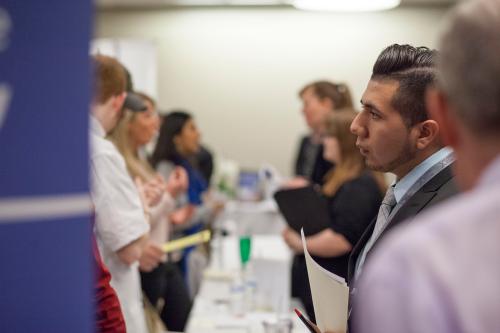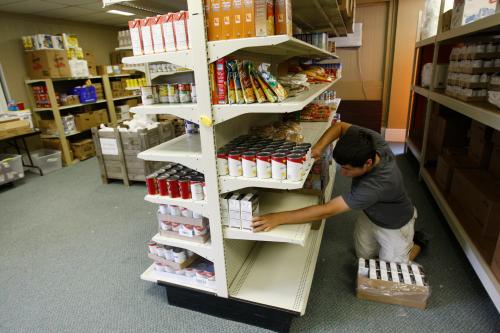Around the country this month, mayors’ offices are deep into planning for their 2018 summer jobs programs. These programs provide work opportunities, most of them publicly subsidized, to hundreds of thousands of teens and young adults who might otherwise struggle to find jobs. They are often a jurisdiction’s largest and highest-profile youth initiative.
Summer youth employment programs (SYEPs) typically come with a long list of goals reminiscent of a late-night infomercial: boosting incomes, improving employability, promoting positive behavior, or giving idle young people something constructive to do (“it slices, it dices!”).
A growing body of research assesses SYEPs against those goals, and finds that they are more effective in reducing crime than increasing subsequent employment. We should take these results as a challenge to clarify what we want out of these programs and to raise a corollary question: do they have the funding, design, and execution to fully reach their stated goals? If not, we are missing out on a tremendous opportunity to engage with young people at a moment in their lives when they are both receptive and vulnerable.
Evaluations of SYEPs: Less crime, but not more work or earnings
A new paper from Alicia Sasser Modestino reports that Boston’s SYEP reduced violent and property crime among participants by 35 and 57 percent, respectively. Modestino’s analysis is the latest to find that SYEPs have positive criminal justice impacts, adding to previous research from New York City and Chicago (two studies, here and here). This growing body of work adds credibility to the findings, suggesting that the crime prevention impacts of summer jobs programs are real and not a fluke.
So far, so good. Crime reduction is often cited as a goal of SYEPs. But the New York City study found that the program did not increase participants’ employment and earnings in the four years after the program. Another more recent evaluation of New York City’s program also found no effects on employment and earnings in the five years after the program (this newer one did not examine impacts on crime). Only one of the two Chicago studies analyzed employment outcomes, but the one that did found no employment increases overall, although it did identify subgroups that showed short-term increases in employment, as did additional research by Modestino. These findings challenge other research that early work experience improves later employment prospects, as well as the intuitively appealing logic that work begets work.
The results also point to the importance of targeting and program design. For young people who are academically behind or face other barriers—an unknown but likely sizable share of SYEP participants—a relatively light-touch intervention of 100-200 hours over the summer is probably not enough to significantly improve their long-term success in the labor market. And not all work experiences are equal: some have engaged supervisors and plenty of learning opportunities, and others, not so much.
Targeting more work-ready young people and ensuring more structured summer jobs could yield different results. In forthcoming research, Modestino will examine the employment impacts of another arm of the Boston SYEP, in which the Private Industry Council (PIC) arranges for participants to interview for unsubsidized slots in the private sector.
Understanding why SYEPs reduce crime
As for violence prevention, insights from the evaluations can help strengthen SYEPs and amplify their impacts. Heller and Davis, authors of the most recent Chicago study, hypothesize that the decline in violence may be driven by increased interpersonal, self-regulation, and conflict management skills. Participants may gain these skills on the job site through interactions with supervisors and co-workers, or in the case of the Chicago program, through supplemental elements, including mentors and use of a social-emotional learning (SEL) curriculum based on cognitive behavioral principles. Modestino has a similar hypothesis; in related research on the Boston program, she found that drops in criminal activity were greater for participants who reported positive improvements in social skills during the summer, including how to manage their emotions and how to resolve conflict with a peer.
The hypothesized causal chain is as follows: 1) youth learn new interpersonal and conflict-management skills on the job, through related curriculum, or mentoring, which 2) causes them to change their behavior even after SYEP ends, which 3) leads them to commit fewer crimes. In that case, the key to maximizing impact is to ensure that participants have the chance to learn those skills.
However, most programs do not currently have the capacity to guarantee a baseline level of quality regarding whether and how these skills are taught. My conversations with program operators (which informed a paper I co-authored with Richard Kazis) and a number of assessments and evaluations point to significant unevenness within and across programs. These programs are huge, and they are decentralized across a dizzying array of worksites. There is substantial variation in the age of participants (with a possible range of 14-24), participant work-readiness and skill level, number of youth per site, supervisor-to-youth ratio, supervisor commitment and engagement, and the nature of the job or enrichment activities. The scale of the program, the compressed time frame, and the budget uncertainty that frequently persists until the last minute greatly limits the ability of program operators to more intensively assess worksites and youth, prepare young people for the workplace, and support adults in supervisory or mentor roles. The programs are impressive logistical achievements, but they are operated with bare-bones organizational capacity. It is difficult for operators to track goals beyond the number of youth served and whether they are paid on time.
Clarify and double down on what works
We should celebrate the positive results that SYEPs are having on criminal behavior, but take them as a point of departure. Let’s get serious about testing the hypothesis that interpersonal and conflict-resolution skills reduce subsequent criminal behavior and explore how to best teach and assess these skills as an integral part of SYEPs—and other youth programming.
And let’s figure out whether, how, and for whom SYEPs can increase later employment. Since most participants are of high-school age, no one expects participants to immediately obtain jobs enabling financial independence, which typically require post-secondary education. But programs can use interim measures and test whether they are associated with longer-term effects. These could include leaving the program with a reference and a letter of recommendation, earning badges to demonstrate mastery of specific skills, connecting participants to mentors for on-going relationships, and so on. Additionally, improved interpersonal skills connected to violence prevention could translate into later employment gains, so it would be useful to probe that more: if those skills are taught more intensively or differently, would that increase subsequent employment?
Other questions relate to both violence prevention and subsequent employment: are impacts different for young people who participate for one summer versus multiple summers? Can we identify subsets of young people most likely to benefit and tailor services accordingly? Would linking SYEPs to employment, youth development, or skill-building activities throughout the year increase effectiveness, and if so, what kinds of activities, specifically?
These are critical issues—not just in research and academia, but also in on-the-ground implementation. In previous writing, my colleague Richard Kazis and I called for increased federal investment to support local SYEPs in developing and testing new approaches to program design and assessment. That is unlikely at this point given the current political climate. But the federal government is not the only branch of government. State and local governments are never looking for ways to increase their budget, but they do care about getting bang for their buck, and if they are already funding summer jobs programs, additional investment geared to capacity building and testing new approaches would allow them to demonstrate that these programs measurably improve communities and participants’ lives. Moreover, while summer jobs programs are expensive from a youth workforce development perspective, they are much cheaper when viewed through a criminal justice lens, given the social costs of crime and incarceration.
This is a great opportunity for other sectors to step up, too, especially those seeking scale. SYEPs are routinely over-subscribed—attracting participants is the least of their problems—and they have strong political and community support that persists across administrations. Philanthropy can support research and evaluation to narrow in on how SYEPs prevent violence, and then to strengthen and target that programming. Foundations could also support SYEPs in performance improvement, evaluation, and capacity-building, including a learning community to accelerate the adoption of best and promising practices. Private sector employers should also be willing to partner with SYEPs: they can offer summer positions with engaged supervisors and clear job descriptions to work-ready young people, and ideally pay wages themselves rather than using subsidies.
In short, SYEPs offer an open policy window for those interested in helping young people—especially disadvantaged young people—grow into thriving adults. We should take advantage of this and leverage the resources already invested in SYEPs to maximize their impact.
The Brookings Institution is committed to quality, independence, and impact.
We are supported by a diverse array of funders. In line with our values and policies, each Brookings publication represents the sole views of its author(s).






Commentary
Let’s invest in summer jobs programs to maximize their impact
February 23, 2018